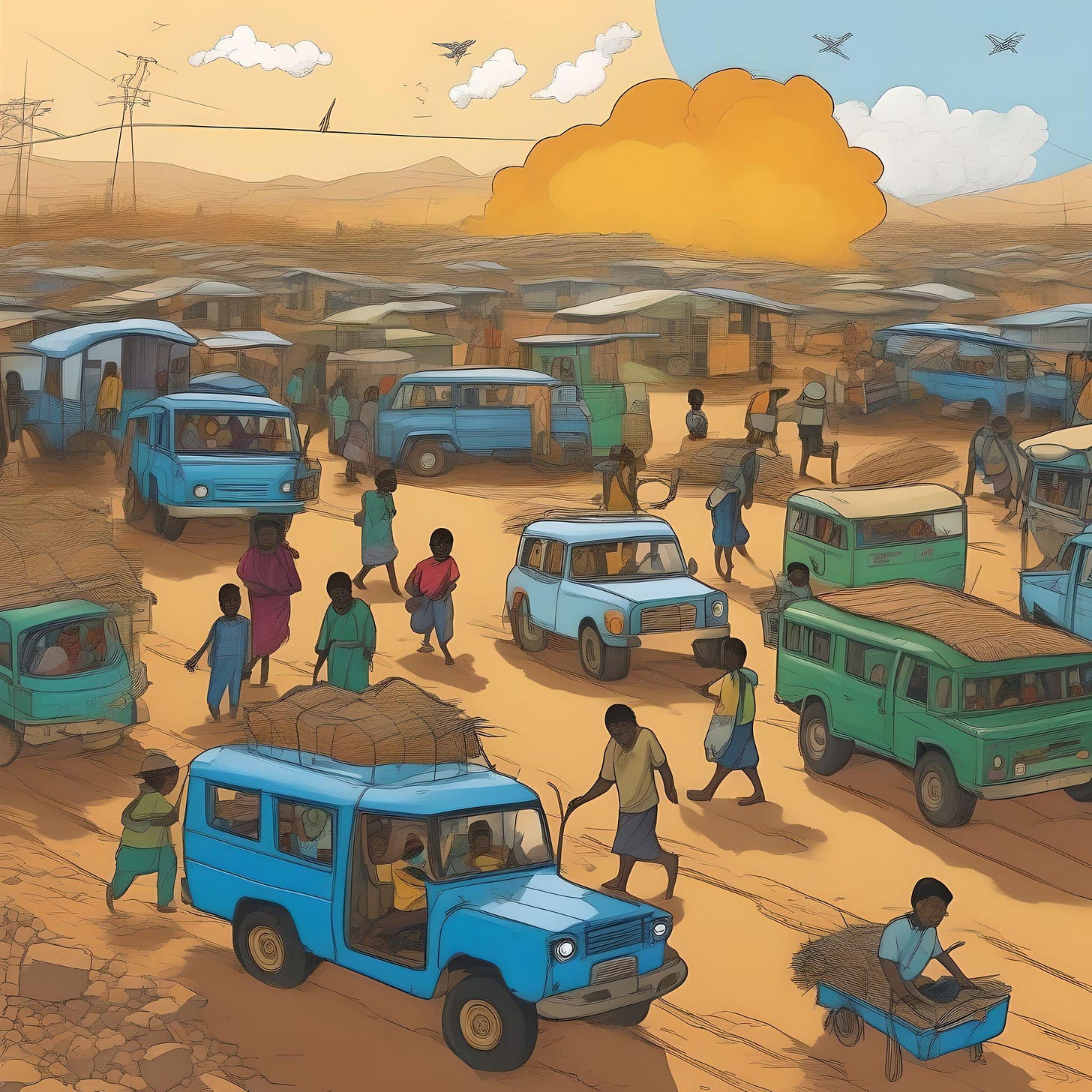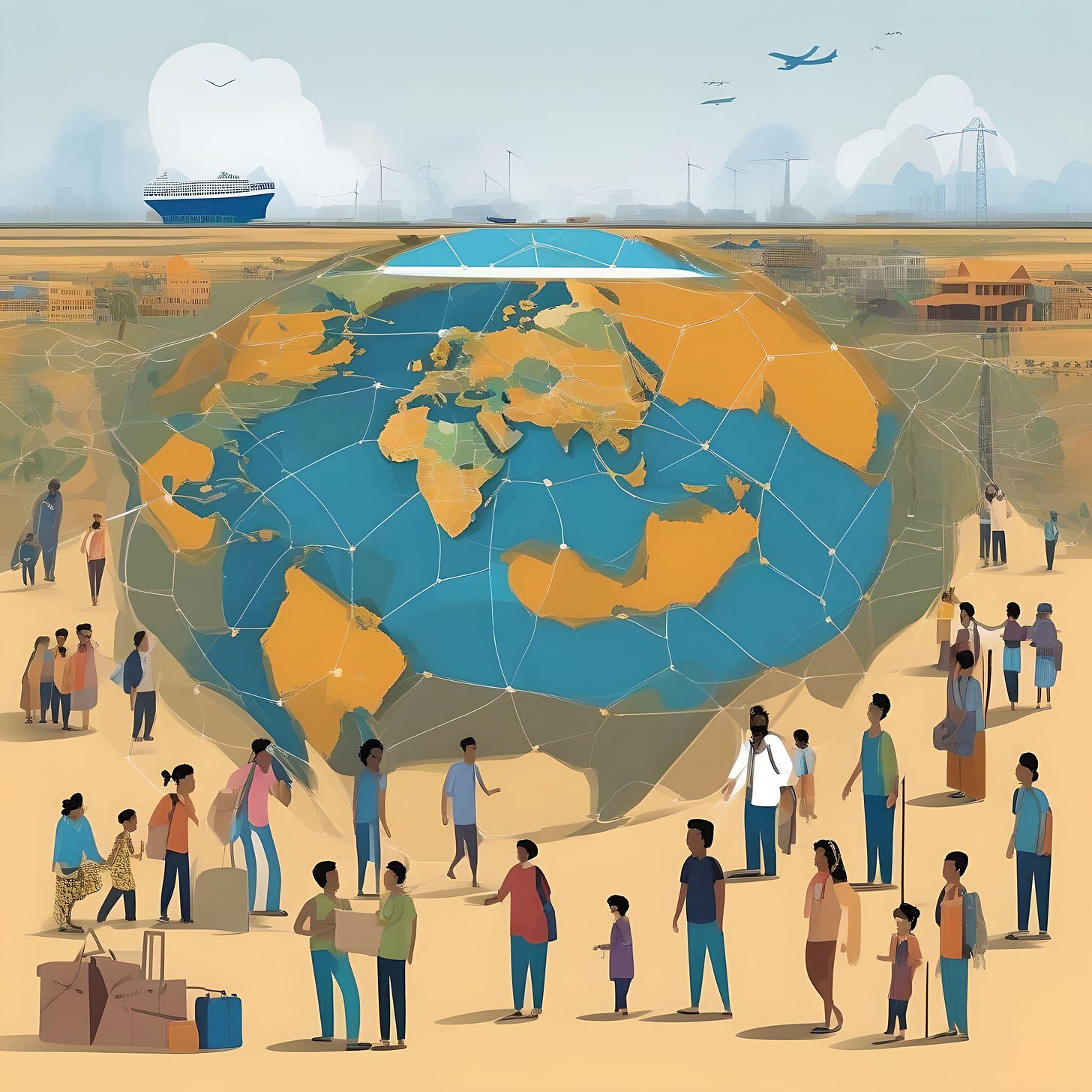(This is a revised post, previously published on Feb 24, updated, expanded and sample questions added)
Human migration—the movement of people across geographical, political, or cultural boundaries—remains one of the most dynamic and complex phenomena shaping our world. This process is not only a testament to human adaptability and resilience but also a key driver of demographic change, cultural evolution, and economic transformation on a global scale. Migration is influenced by a tapestry of interwoven factors, ranging from economic necessity to environmental pressures, and from political instability to the pursuit of personal aspirations. By examining the diverse forces that propel and attract people across borders, we gain crucial insights into the intricacies of migration and are better equipped to address its multifaceted challenges and opportunities in our increasingly interconnected world.
Push and Pull Factors: A Foundational Framework
Migration scholars have long relied on the "push-pull" framework to analyse why people move. This model distinguishes between push factors—conditions that compel individuals to leave their place of origin—and pull factors—attributes that attract them to a new location. While this binary is helpful, the reality is often far more nuanced, with overlapping motivations and influences.
Push Factors: Forces Driving People Away
Economic Hardship: Persistent poverty, high unemployment, underemployment, and stark inequality remain powerful push factors. According to the World Bank’s 2024 Migration and Development Brief, remittances to low- and middle-income countries reached a record $669 billion in 2023, reflecting continued economic migration as individuals seek better livelihoods abroad (World Bank, 2024).
Political Instability and Conflict: Ongoing wars, civil unrest, authoritarian regimes, and human rights violations create unsafe living conditions. The United Nations High Commissioner for Refugees (UNHCR) reported that by mid-2024, the number of forcibly displaced people worldwide had surpassed 120 million, the highest ever recorded, driven by conflicts in Ukraine, Sudan, Gaza, and elsewhere (UNHCR, 2024).
Environmental and Climate Pressures: Climate change, extreme weather events, and environmental degradation are increasingly significant. The Internal Displacement Monitoring Centre (IDMC) estimated that over 30 million people were displaced by disasters in 2023 alone, while projections suggest that climate-related migration could affect up to 250 million people by 2050 (IDMC, 2024; Cundill et al., 2023).
Demographic Pressures: Rapid population growth in some regions, coupled with limited access to education, healthcare, and housing, can exacerbate the desire to migrate, especially among younger generations seeking better futures.
Pull Factors: Attractions Drawing People In
Pull factors, on the other hand, act as attractive forces, drawing individuals to specific destinations. These can include:
Economic Opportunities: Higher wages, more abundant job prospects, and improved living standards are strong magnets. Research published in the Journal of Migration Studies (2023) underscores the enduring role of wage differentials and labour market demand in shaping migration flows (Meyer et al., 2023).
Social Networks and Diaspora Communities: The presence of established migrant communities in destination countries can ease integration, provide social support, and reduce the risks associated with migration. Social networks often facilitate the flow of information, resources, and even job opportunities, making migration more feasible and attractive (Vargas-Silva, 2023).
Political Stability and Safety: Countries with robust legal systems, respect for human rights, and low levels of violence are preferred destinations for those fleeing instability. The 2024 Global Peace Index highlights that nations such as Iceland, New Zealand, and Portugal continue to be among the most peaceful and attractive to migrants (Institute for Economics and Peace, 2024).
Educational and Professional Advancement: Many migrants are drawn by the prospect of better educational opportunities for themselves or their children, as well as the chance to develop skills and careers in more dynamic economies.
Beyond Push and Pull: The Complexity of Migration Decisions
While the push-pull framework offers a valuable lens, it is increasingly clear that migration decisions are rarely the result of a single factor. Instead, they emerge from a complex interplay of personal circumstances, family considerations, aspirations, and perceptions of risk and opportunity. For example, environmental degradation may simultaneously push individuals from their homes and pull them toward regions with more stable resources and infrastructure. Additionally, migration is often a household or community strategy rather than an individual choice, reflecting collective risk management and investment in the future.
Recent scholarship emphasises the role of "aspirations-capabilities"—the idea that migration occurs not just when people are pushed or pulled, but when they have both the desire and the means to move (Carling & Schewel, 2018). Digital connectivity, access to information, and transnational ties are also reshaping how and why people migrate in the 21st century.
Understanding the Impact: Opportunities and Challenges
Migration has profound effects on both sending and receiving societies. It can:
Drive Economic Growth: Migrants contribute to labour markets, entrepreneurship, and innovation. The OECD (2024) reports that migrants accounted for nearly 15% of new business start-ups in high-income countries in 2023.
Foster Cultural Exchange: Migration enriches societies by introducing new ideas, cuisines, languages, and traditions, fostering greater diversity and creativity.
Support Development: Remittances sent home by migrants are a vital source of income for millions of families and play a crucial role in poverty reduction and community development.
However, migration also poses challenges:
Integration and Social Cohesion: Rapid demographic change can strain public services and fuel social tensions if not managed inclusively.
Resource Pressures: Influxes of people may place pressure on housing, healthcare, and education systems, especially in urban centers.
Protection of Rights: Migrants, especially those with irregular status, are often vulnerable to exploitation, discrimination, and abuse.Beyond the Binary:
While the push-pull framework provides a helpful starting point, migration decisions are rarely driven by single factors. Individual circumstances, aspirations, and perceptions play a crucial role in shaping migratory choices. Moreover, the lines between push and pull factors can blur. For example, environmental degradation can both push individuals out of their homes and pull them towards areas with more stable resources.
Moving Forward: Toward Equitable and Sustainable Migration
Addressing the complexities of migration in the 21st century requires coordinated, evidence-based policies and international cooperation. Key priorities include:
Tackling Root Causes: Investing in development, conflict prevention, and climate resilience in countries of origin can reduce forced migration.
Ensuring Safe and Orderly Migration: Expanding legal pathways, improving border management, and combating human trafficking are essential for protecting migrants’ rights.
Promoting Inclusion: Policies that support integration, recognise migrants’ skills, and foster intercultural dialogue benefit both migrants and host communities.
Leveraging Data and Research: Ongoing research and data collection are crucial for understanding migration trends and designing effective interventions.
In sum, migration is an enduring feature of human society, shaped by a constellation of forces that are constantly evolving. By embracing a holistic and humane approach, we can harness the benefits of migration while addressing its challenges for the betterment of all.
References
Carling, J., & Schewel, K. (2018). Revisiting aspiration and ability in international migration. Journal of Ethnic and Migration Studies, 44(6), 945-963.
Cundill, G., et al. (2023). Climate change and migration: New evidence and policy directions. Nature Climate Change, 13(2), 110-117.
Institute for Economics and Peace. (2024). Global Peace Index 2024.
https://www.economicsandpeace.org/
Internal Displacement Monitoring Centre (IDMC). (2024). Global Report on Internal Displacement 2024.
https://www.internal-displacement.org/
Meyer, S., et al. (2023). Economic drivers of migration: A global analysis. Journal of Migration Studies, 12(1), 45-67.
OECD. (2024). International Migration Outlook 2024. https://www.oecd.org/migration/
UNHCR. (2024). Global Trends: Forced Displacement in 2024. https://www.unhcr.org/global-trends
Vargas-Silva, C. (2023). Migration networks and integration. Population and Development Review, 49(3), 601-623.
World Bank. (2024). Migration and Development Brief 41. https://www.worldbank.org/en/topic/migrationremittancesdiasporaissues/brief/migration-and-development-brief
Clemens, M. A., Montenegro, R., & Pritchett, L. (2020). The economic motives of international migration. Journal of Development Economics, 144, 102371.
Rigaud, K., de Sherbinin, M., Jones, B., Bergmann, J., Clement, V., Ober, K., ... & Fuchs, S. (2021). World in Motion: How Climate Change Is Increasing Migration. Nature Climate Change, 11(3), 346-354.
Munshi, K., & Rosenzweig, M. R. (2006). Networks in migration: Theory, measurement, and application. Population and Development Review, 32(4), 503-529.
Examination Questions
Multiple Choice Questions
Which of the following is NOT typically considered a push factor for migration?
a) Political instability
b) High unemployment
c) Presence of diaspora communities
d) Environmental disasters
According to the 2024 Global Peace Index, which of the following countries is among the most peaceful and attractive to migrants?
a) Iceland
b) Syria
c) Afghanistan
d) Sudan
Which organisation reported that global remittances to low- and middle-income countries reached a record $669 billion in 2023?
a) UNHCR
b) OECD
c) World Bank
d) IDMC
Short Answer Questions
Define the "push-pull" framework in the context of human migration.
List and briefly explain two environmental factors that can drive migration.
What is meant by the “aspirations-capabilities” approach in migration studies?
Name two challenges and two opportunities associated with migration for receiving countries.
How do social networks influence migration patterns?
Data Interpretation/Source Analysis
According to the Internal Displacement Monitoring Centre (IDMC), how many people were displaced by disasters in 2023, and what is the projected number of climate-related migrants by 2050?
Summarise the role of remittances in the context of migration and development.
Essay/Extended Response Questions
Discuss the limitations of the push-pull framework in explaining contemporary migration patterns. Use examples from the provided text to support your answer.
Evaluate the economic, social, and political impacts of migration on both sending and receiving countries. Include recent data and examples in your response.
“Migration is both a challenge and an opportunity.” Discuss this statement with reference to current trends and policy responses outlined in the text.
Critical Thinking
Propose two policy measures that could help address the root causes of forced migration. Justify your choices using evidence from the text.
How might climate change alter global migration patterns in the next 25 years? Use information from recent studies and projections.







